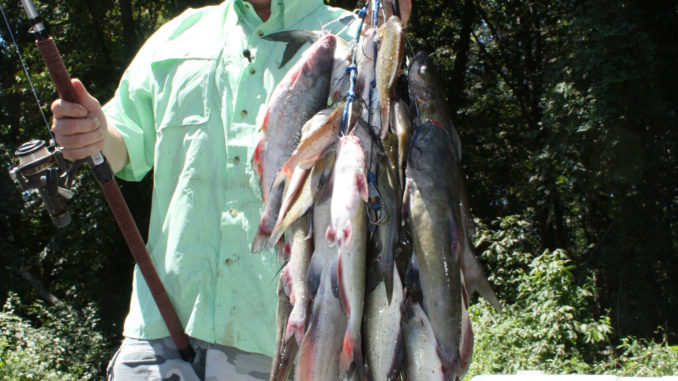
Catalpa worms are No. 1 bait for boating river blues, channels and flatheads
The Santee Cooper lakes, Marion and Moultrie, get a lot of attention for catfishing, and deservedly so. But the catfish action upstream from Lake Marion on the Congaree River is overlooked by many fishermen.
But not by Whitey Outlaw of St. Matthews.
Outlaw has fished the Congaree River for years and is mauling its catfish population right now.
“My bait of choice is catalpa worms, and right now the catfish are eating them as fast as we can thread them on a hook and cast into the water,” Outlaw said. “The Congaree River is just an extension of upper Lake Marion, so we’ve not only got lots of catfish, but plenty of big fish. Using catalpa worms, we can realistically expect to catch all three of the major species – blue, channel and flatheads – on any given trip, plus some big bream. We typically catch fish in the 15-pound class up to 30 pounds, and fish that size, with the current in the river, creates some exciting times.”
Outlaw said a key to catching fish is finding the right spots. He said typical targets are both the outside bends where the water is often slightly deeper as well as the inside bends where there are sandbars, specifically where the banks are lined with willows.
“Both can be ideal places, and it depends on water color and current, so I fish both to establish a pattern,” said Outlaw, who also fish around logjams where eddies that will attract catfish, as well as high, steep banks.
“I keep it simple, usually no anchor. I just tie up to one of the many snags in the river or the willow bushes along the edge of the inside river drop,” Outlaw said. “We seldom fish the middle of the river. The technique is to simply thread a catalpa worm, or whatever bait you use, on the hook, and cast to both deep and shallow water. Often I don’t get all the rods out before fish are biting. Typically we’ll catch several very quickly, and when it slows I move.”
“One reason I move so much is occasionally I’ll hit a super-hot spot and catch a bunch of fish real quick, many in the 5- to 15-pound class,” he said. “I move around and try different-type areas until I get a pattern for the day. These kinds of or anything unusual are places I’ll fish. I’ll always cast a rig or two close to the bank and often catch big catfish out of that skinny water.”
Outlaw said that the proper tackle and rigging is crucial.
“I’m using the 8-foot B ‘n’ M Silver Cat catfish rods,” he said, “They have the
light tip needed to detect bites without spooking fish, but enough backbone muscle to set the hook and handle huge fish. I spool 14-pound Vicious line on my reels, but I use an 18-inch leader of 50-pound test and a 2/0 hook at the terminal end. Based on the current, I’ll have a ¾- to 1-ounce sinker above the swivel.”
Outlaw said don’t let the lack of catalpa worms keep you from going because other baits will work. Shrimp are his No. 1 backup bait, but other traditional catfish baits will produce.
“When you thread a catalpa worm on the hook, hold on tight, because right now, the catfish bites will come rapidly and repeatedly,” Outlaw said.





Be the first to comment